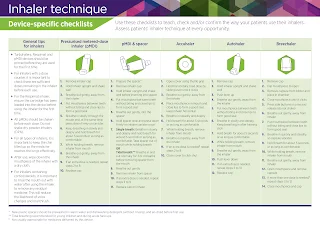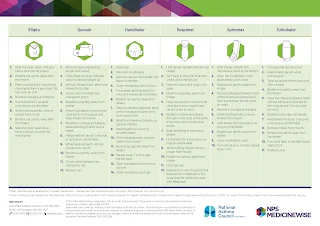Inhalers
Introduction
There are currently 3 main types of aerosol-generating device for use in inhaled drug therapy.
Inhaler Techniques
Poor inhaler technique has been reported among children and adults, including experienced inhalers.
- Incorrect technique → More symptoms →Worse adherence → More exacerbations → Higher environmental impact.
- Hence, correcting patients' inhaler technique can improve asthma and COPD control, quality of life and lung function.
To learn step-by-step guide of how to use an inhaler, you may refer
- Handling of Inhaler Devices, 2011
- Garis Panduan Kaunseling Ubat-ubatan, 2019
- A Guide to Aerosol Delivery Devices for the Respiratory Therapist, 2018
- Lung Foundation Australia Inhaler Device Technique, 2018
- Asthma + Lung UK Inhaler Demonstration Videos, 2022
- National Asthma Council Australia - How-to videos
Common Errors
Experience shows that patients commonly make a few key errors when using inhalers, and these errors should be carefully addressed.
Common errors with pressurized metered-dose inhalers include
- Failing to shake the inhaler before actuating
- Holding the inhaler in wrong position (e.g. not upright)
- Failing to exhale fully before actuating the inhaler
- Exhaling into the inhaler
- Actuating the inhaler too early or during exhalation (the medicine may be seen escaping from the top of the inhaler)
- Actuating the inhaler too late while inhaling
- Actuating more than once while inhaling
- Inhaling too rapidly (this can be especially difficult for children to overcome)
- Failing to hold breath long enough after inhaling
- Multiple actuations without shaking between doses
- Using the inhaler when empty
Common errors for dry-powder inhalers include
- Tilting the device while loading the dose instead of keeping it in the correct position (horizontal for Accuhaler and vertical for Turbuhaler)
- Shaking the device
- Failing to exhale fully before inhaling
- Failing to inhale completely
- Inhaling too slowly and weakly
- Exhaling into the device mouthpiece before or after inhaling
- Failing to close the inhaler after use
- Using past the expiry date or when empty
In-Check Dial G16
- For example, MDIs typically require slow inspiratory flow (<30 L/min) with a breath-hold, while a DPI may require significantly high flows (30-90 L/min) based on their resistive properties to disperse a full dose.
- MDIs and soft-mist inhalers require a slow and steady inhalation over 3-5 seconds to minimise deposition of the drug in the oropharynx and optimise delivery to the lungs.
- On the other hand, more inspiratory effort is needed for DPIs, because they rely on the patient’s ability to produce sufficient airflow to break up and disperse the powder and deliver the dose. This requires a full breath out (exhalation to the patient’s functional residual capacity or residual volume), followed by a forceful, deep inhalation over 2 to 3 seconds.
The In-Check Dial G16 is recommended to train the patients to inhale at a suitable flow rate by stimulating the resistance of specific inhalers.
- It provides patients with objective feedback on their inspiratory force, replacing arbitrary descriptions like 'slow' or 'strong' inhalation.
Summary
The best way to train patients to use their inhalers correctly is one-to-one training by a health professional (e.g. nurse, pharmacist, GP) that involves both verbal instruction and physical demonstration.
- Patients do not learn to use their inhalers properly just by reading the manufacturer’s leaflet.
- When instructing patients on inhaler use, physical demonstration is highly effective. For instance, physically moving the DPI away while demonstrating complete exhalation before inhalation, and visibly holding one's breath for 6-10 seconds after inhalation, reinforces correct technique and solidify patient's understanding.
When prescribing inhaled medicines, make sure the inhaler is appropriate for the patient’s age, developmental stage, cognitive function, inspiratory effort and dexterity.



May I know is there any age limit for children to use easyhaler? At which age can switch to easyhaler? Or any considerations to start patient with easyhaler?
ReplyDeleteIt is a case-to-case basic approach because it depends on if the child is able to use the easyhaler correctly. At my facility, we consider this as an option for children who are going to school because it is less bulkier than combination use of aerochamber and mdi.
DeletePaediatric protocol for Malaysian Hospitals suggests to only consider dry powder inhaler for children above 8 years. MDI plus spacer with mask is suggested to all children 8 years and below.
At the moment, easyhaler is not available in the Malaysia market. Your facility may need to apply an import permit to get it.
Hi, have you written any articles on SMART Turbuhaler Therapy? I've searched your site and did not find any. Would like to read your writings on SMART Therapy. Thanks.
ReplyDeleteSince year 2019, GINA guidelines for asthma no longer recommends treatment with SABA alone, without inhaled corticosteroids. The overuse of SABA-only treatment is associated with increased risk of exacerbation and lower lung function.
DeleteSymbicort contains both an inhaled corticosteroid (budesonide) and long-acting bronchodilator medication (formoterol). In SMART therapy, Symbicort can now be prescribed both as a controller and reliever therapy (in the past, Symbicort was used only as a daily asthma controller).